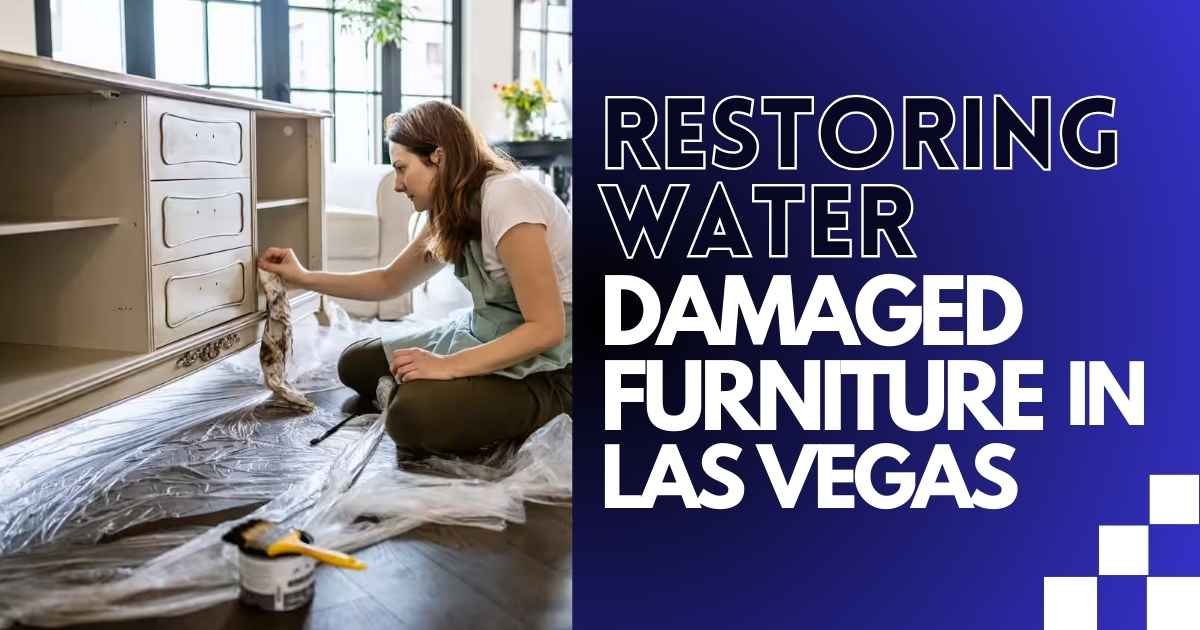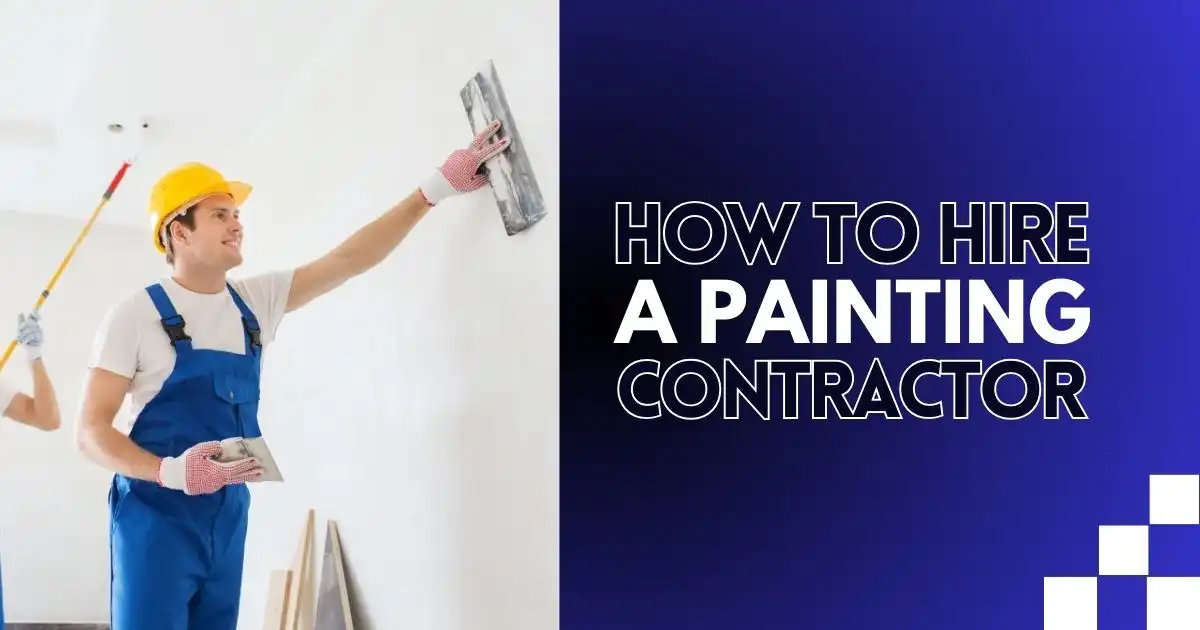Twenty percent of homes in Las Vegas face water damage each year, usually from leaks, burst pipes, or flash floods. This problem is worsened by old infrastructure and changing weather in the area.
Serious water damage in homes often happens due to heavy rains, floods, or too much water spilling over, causing major harm to items like carpets and furniture. While it may seem like ruined furniture can’t be saved, water damage isn’t always permanent.
In many situations, water damaged furniture can be repaired, although it might not look exactly the same as before. Wooden or cushioned furniture can be restored with the right care and techniques.
How Does Water Damage Affect Your Furniture?
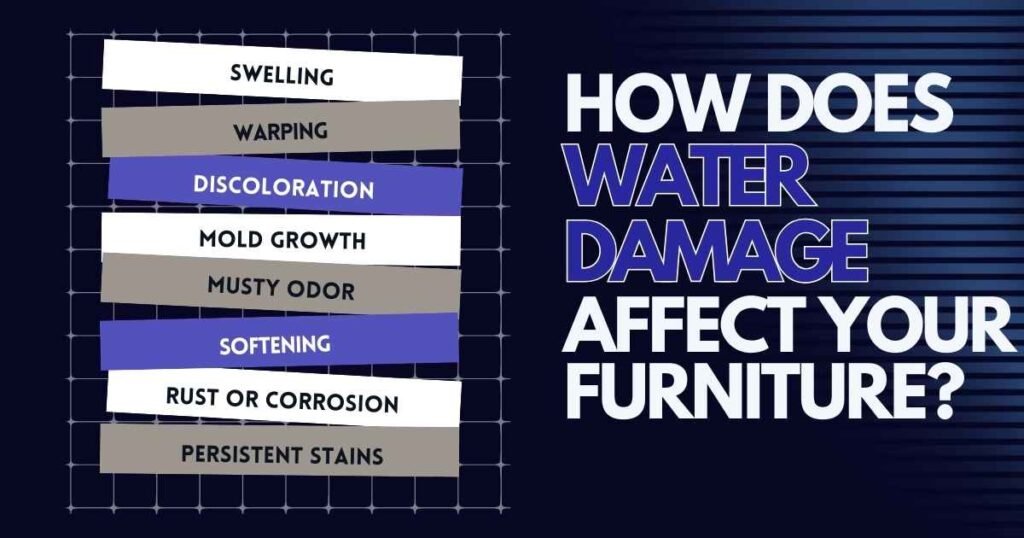
Water damage can appear in different forms, each bringing its own set of challenges when it comes to restoration. Wooden furniture is particularly at risk, as too much moisture can cause it to swell and shrink, weakening its structure.
Upholstered furniture is also affected, as water can lead to stains, bad odors, and mold growth. Ignoring these issues can make the damage worse, leading to permanent problems for your furniture.
Here are some key signs of water damage:
- Swelling: Wood furniture may swell and change shape as it absorbs water.
- Warping: Water can cause surfaces to bend or become uneven.
- Discoloration: Stains or changes in color on the surface can indicate moisture problems.
- Mold Growth: Mold or mildew on fabric or wood surfaces suggests long-term moisture exposure.
- Musty Odor: A lingering musty smell can be a sign of mold or mildew due to water damage.
- Softening: Wood or fabric that feels soft or weak shows signs of water saturation.
- Rust or Corrosion: Metal parts of the furniture may rust or corrode from ongoing water exposure.
- Persistent Stains: Water stains on fabric that won’t come out can be a clear indication of damage.
Tips for Repairing Wooden Furniture
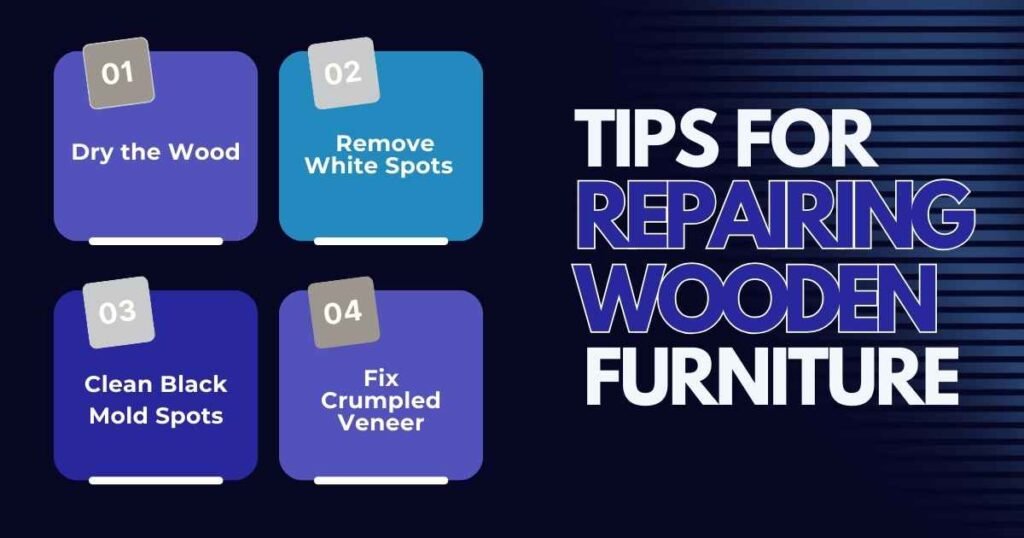
1. Dry the Wood
After water damage, drying the wood quickly is important to avoid further harm. Moisture can seriously damage wood if left unchecked. Place the furniture in direct sunlight or use fans and dryers to speed up drying. Be cautious of the weather; cold can slow the process and encourage mold, while too much heat may cause the wood to crack.
2. Remove White Spots
Contaminated water often leaves white spots on wooden furniture. These can be fixed easily. Mix equal amounts of baking soda and toothpaste to create a cleaning solution. Use a cloth with this mix to gently rub away the spots, then polish the wood with a dry cloth to restore its shine.
3. Clean Black Mold Spots
Water damage can also lead to black mold spots, indicating that moisture has seeped deep into the wood. To fix this, first strip the damaged finish, clean the mold with a peroxide solution, and apply a new finish to restore the wood.
4. Fix Crumpled Veneer
Water can cause the veneer on wooden furniture to wrinkle. To repair it, first, soak the veneer with a moisturizer until it flattens out. Clean and dry the surface, then inject veneer glue between the wood and coating using a syringe. Apply pressure with a heavy block to ensure the glue sets properly. Let it dry fully before removing the block.
How to Restore Upholstered Furniture
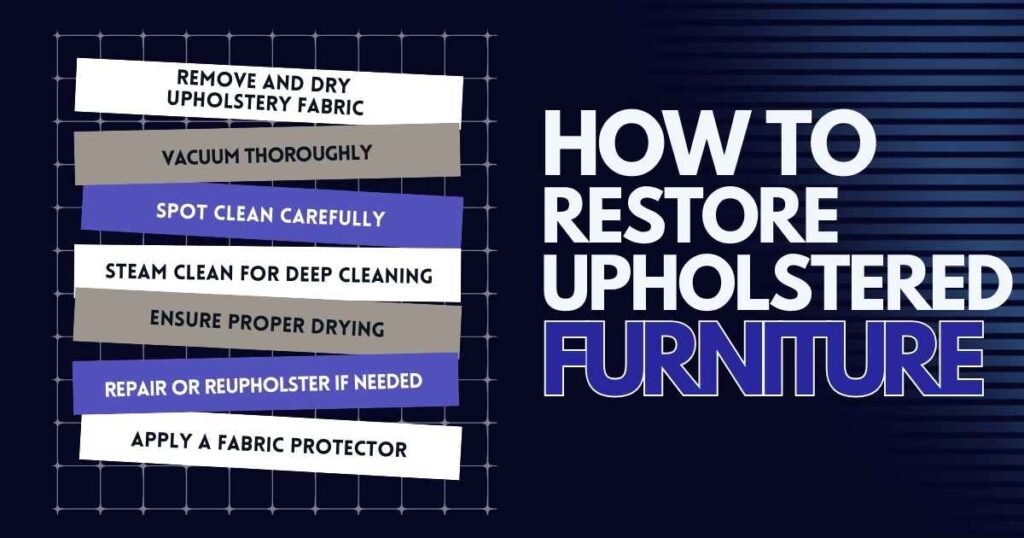
Restoring water damaged upholstered furniture can be tricky, but with the right steps, you can bring your favorite pieces back to life. From drying the fabric to dealing with tough stains and odors, the process requires careful attention.
Here are some simple steps to help you effectively restore water damaged upholstery:
1. Remove and Dry Upholstery Fabric
Carefully take off the upholstery fabric to avoid tearing or additional damage. Let it dry naturally in a space with good airflow. It’s best to avoid using heat tools like hair dryers, as high heat can shrink or warp the fabric, leading to further damage. Sunlight can be helpful for drying, but don’t leave the fabric out too long, as UV rays may cause fading.
2. Vacuum Thoroughly
Use a vacuum with a soft brush attachment to gently remove dirt, dust, and debris embedded in the fabric. This step helps avoid rubbing dirt into the material during the cleaning process. Be sure to vacuum the crevices, as trapped dirt can cause odors and contribute to mold growth.
3. Spot Clean Carefully
For stains, mix a small amount of mild detergent with water and apply it using a clean cloth. Blot the stain rather than rubbing it to prevent the stain from spreading. For stubborn stains, you may need to repeat the process a few times, but avoid oversaturating the fabric.
4. Steam Clean for Deep Cleaning
For a deeper clean, use a steam cleaner specifically designed for upholstery. Steam cleaning helps eliminate bacteria, dust mites, and deep-set dirt that regular cleaning can miss. Be sure to follow the steam cleaner’s instructions to avoid soaking the fabric or causing color changes. Test a small hidden area first to check for any adverse reactions.
5. Ensure Proper Drying
After cleaning, it’s important to let the fabric dry thoroughly. Place it in a well-ventilated area and consider using fans to speed up drying. Avoid placing the fabric back on the furniture until it is completely dry to prevent mold and mildew. Mold can develop within 24-48 hours if the fabric remains damp.
6. Repair or Reupholster if Needed
If the fabric has tears, worn spots, or other significant damage, small repairs like stitching patches may work. However, if the damage is extensive, reupholstering might be necessary. For valuable or antique furniture, consider consulting a professional to ensure the repairs are done correctly.
7. Apply a Fabric Protector
Once the upholstery is restored, applying a fabric protector spray can help shield against future spills and water damage. These sprays create a water-resistant barrier on the fabric, making future cleanup easier. Be sure to apply the protector evenly and follow the product’s directions for the best results.
Professional Restoration of Water-Damaged Furniture
Knowing how to restore water damaged furniture and upholstery is key to saving and extending the life of valuable items. Quick action can stop further issues like mold growth and structural damage, which helps save time and money in the long run.
Getting help from professionals is important because they have the right skills and equipment to perform a complete and effective restoration. Companies like Vegas Plumbing Pros can evaluate the damage accurately and apply the correct methods to reduce the risk of permanent damage, ensuring your furniture is properly restored.
This approach helps protect your investment, maintain the quality of your belongings, and create a safe, healthy living environment.
Final Thoughts
While water damaged furniture can be challenging, quick and careful action is important to saving your pieces. Identifying damage early and using proper restoration methods like drying, cleaning, and repairs can help restore your furniture’s look and functionality.
Even with significant damage, techniques like reupholstering or refinishing can give it a second life. Preventative care, such as using fabric protectors and regular checks for moisture, also helps extend your furniture’s lifespan and avoid future issues.
FAQs
How do you dry water-damaged furniture?
To dry water damaged furniture, place it in direct sunlight or use fans and dryers to speed up the drying process. Be careful with extreme weather conditions, as too much heat or cold can cause more damage. Good ventilation is important to stop mold and mildew from growing while the furniture dries.
How do you remove water damage from a couch?
To remove water damage from a couch, start by taking off the upholstery fabric and letting it dry completely. Next, spot clean any visible stains using a mild detergent solution. For deeper cleaning, you can use a steam cleaner. Make sure the fabric is fully dry before putting the couch back together to avoid mold. If the damage is severe, you might need to reupholster or repair the couch.
How can you identify water damage in furniture?
You can spot water damage in furniture by looking for signs like swelling, warping, discoloration, mold growth, bad odors, soft spots, rust, or tough stains. These issues show that the furniture has been exposed to too much moisture and needs care to prevent further harm.
How to fix water damaged swollen wood furniture?
To fix water damaged swollen wood furniture, first, let it dry completely in a well-ventilated area. For minor swelling, gently press the area with a clamp or use a cloth and iron to remove moisture. If swelling persists, sand the area smooth and refinish it. For severe damage, replacing the affected section might be needed. These steps can help restore the furniture to a usable condition.
